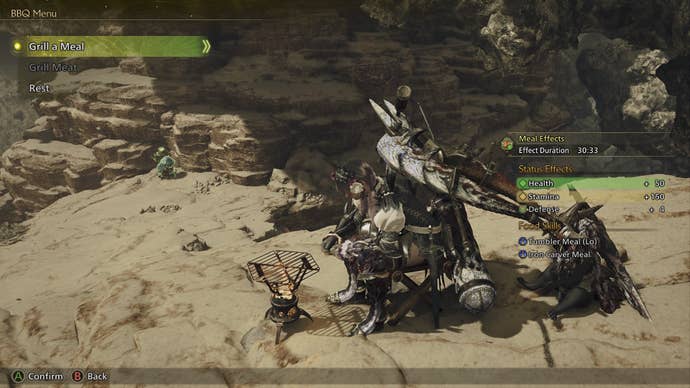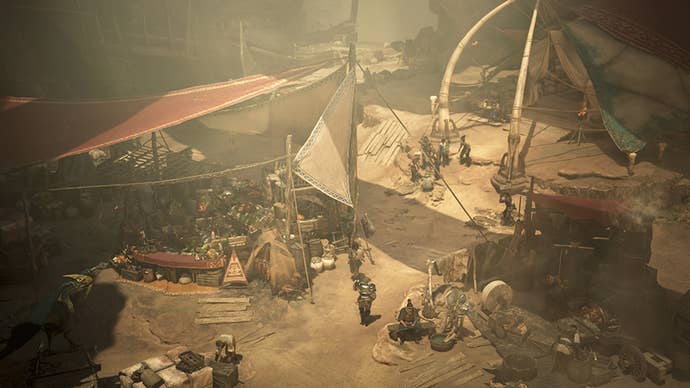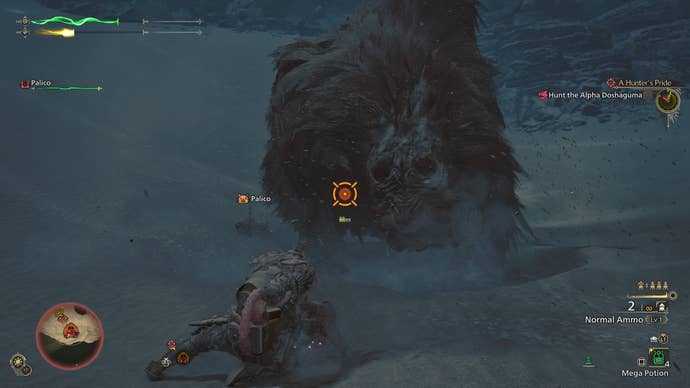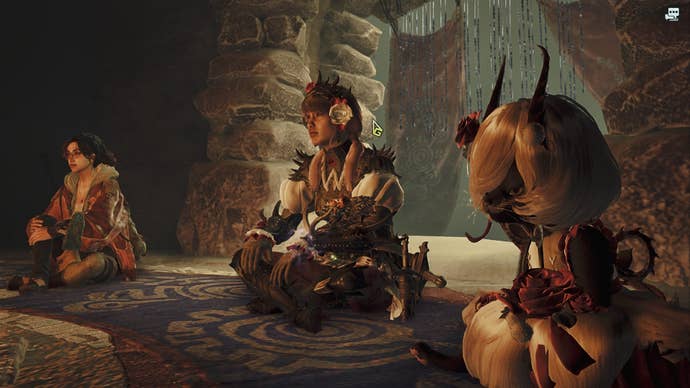Do you have a favourite travel destination? Somewhere you just can’t stop going back to, even though you know there’s a whole world out there to see? That’s Monster Hunter, for me. It’s a holiday. A fantastical sabbatical from a real life that is often painful, exhausting, and overwhelming. Even though you’re carving up dragons, covering your ears from earth-rumbling roars, eating thunderbolts on the daily, and getting your nice new armour burned to a crisp with alarming regularity, Monster Hunter is a recess, a break, a sojourn.
But Monster Hunter Wilds is a bit different. It’s like going on holiday to your favourite country… but going to a new city. It’s familiar enough that you speak the language and recognise the cuisine, but the customs are a bit different. The people behave slightly differently. The shops are loaded with items you don’t remember. It’s deja vu, not muscle memory. It’s a feeling of familiarity, not complete comfort. And it’s the change you never knew you needed.
Capcom is clearly emboldened right now. It is so confident, in fact, it’s willing to tinker with its most reliable (and best-selling!) formula. Good. Monster Hunter is no stranger to innovation, just look at the last game’s DLC offering and you’ll see what I mean. But Wilds is the sequel to World, the most profitable Monster Hunter to date. Playing it safe, Capcom could have churned out more of the same and sat back, counting the pennies. But it chose not to rest on its laurels, and instead stuck its hand into the belly of the beast and started rearranging the innards. The result is a chimera that is smarter, stronger, faster, friendlier, but – curiously – more simplistic.
The most obvious change is in the story. Since Rise and Sunbreak, we’ve seen the series try and force more narrative around the skeletal ‘hunt, carve, craft, hunt’ structure it made its name on. In Wilds, the narrative is in your face. The old ‘post a quest, teleport into a zone, do a hunt’ rhythm is scuppered, replaced with a more fluid path. Wilds has a more open-ended set-up, allowing you to roam from hub world to play area on a whim. It means you get to see more of the world in its natural state, and feel way more immersed in the intricate eco-system Capcom has spent years layering up. There is a lot of focus on ‘auto-riding’ that robs you of agency to a degree, and there are periods where you can be completely hands-off for minutes at a time. A cardinal sin in a Monster Hunter game, if you ask me.
That also means you have to sit through a lot of idle chatter. How much tolerance you have for the paper-thin story will depend on your patience for anime tropes, fan service, and mediocre voice acting. It all looks absolutely stunning, though, so at least there’s that. I don’t find the story too egregious (you can always skip it) and I’m sure it’s a nice touch for people who want something a bit more arch to tie all their PETA-riling animal murders together. But it’s not for me. It’s too obvious, takes itself too seriously, and feels woven together with fibers made out of tropes, stereotypes, and cliches.

I don’t play Monster Hunter for the story. I never have, and never will. It’s set dressing, side salad, a cute enamel pin on an eye-catching outfit. The real meat of Monster Hunter is the gameplay, and let me tell you… when you are actually fighting (especially in the post-game HR portion), Wilds is the best Monster Hunter Capcom has ever cooked up.
All 14 weapons return from the previous games, but now you can carry two into battle with you. Want to use something that can slice off tails, and something that can shoot out eyeballs? Go ahead. Want to take two different gunlances in so you can poison a big lizard and then set it on fire? It’s your game. This alone would be enough of a change-up to keep the game fresh and entice old players back, but there’s more. There’s so much more.
Take wounds; gaping injuries on a monster’s body that can be exploited for huge damage, elemental or status build-up, and that provide more materials when you destroy them. It makes fights way more dynamic, and gives you more options in moment-to-moment fighting that pads out the macro experience to keep things engaging, back to front.
It used to be that a Monster Hunter fight had a strict rhythm; engage with a beast, fight it for a bit, pursue it to a new area, fight it for a bit, break a part of its body, pursue it again, and capture or kill it. That dance is still the same in Wilds, but now you can incorporate more fancy footwork in the middle. At any point, you can create a wound and start trying to rip it open. You get to dictate more of the combat flow. There are more choices per fight, and you’re always weighing up the most efficient next move. It’s moreish, succulent, a treat to the palate.

And when you start to realise there is more depth than ever to how the world works, you see all the options on the flowchart expand again. The entire Monster Hunter Wilds experience is like opening up a skill tree in a game and zooming out, and zooming out, and zooming out. More and more stuff starts to become visible, and it’s overwhelming and fascinating and exciting.
One of my favourite moments in the game was fighting a Rey Dau – a thunder dragon, basically – in the starting area. It’s a ‘boss fight’, if you like, a threshold to harder content. During the fight, a herd of p**sed-off buffalo-like monsters (Doshaguma) stormed into the melee. They were panicked, and the alpha monster started butting heads with the Rey Dau. The dragon was screeching and flinging lighting everywhere. The herd was conducting electricity, getting agitated, and causing a rumpus. It was carnage, and me and my fellow hunters were in the middle of it, trying to make sense of everything. Eventually, the herd departed, the Rey Dau had been stunned and knocked to the ground, and there were bits of monster everywhere.
It was totally unscripted, and I have done the same fight at least six times since and the same thing has never happened again. The ecosystem and the living world that Capcom has alchemized is so complicated and intricate that I am still left gob-smacked, long after the credits have rolled (both times). I won’t spoil things here, but there are so many variations of monsters – and ways in which monsters that live somewhere else can appear in new environments – that I truly don’t think one player will ever see absolutely everything this game has to offer. It’s staggering. And, in my opinion, more than makes up for the smaller monster roster than World.

Monster Hunter Wilds isn’t quite open world. It’s a series of huge areas knitted together with elaborate pathways and multi-layered environments. You can be careering over the canopies of a forest one minute, and exploring the dank, subterranean depths of a hollowed-out oil well the next. You can be blinded in a snowstorm, or buffeted by rain. You can be hopping away from lightning, or basking in the sun on the open plains. RE Engine is a magical piece of tech, and it feels like Capcom is juicing it on all cylinders in Wilds.
You can see it in the animations, too. There is so much subtlety to how monsters behave, it’s mind-blowing. The marionette spider, Lala Barina, moves like a stop-motion puppet. The [redacted] versions of returning monsters tremble with rage and shiver with raw power. The hunters, too, handling their weapons, just look right. I have no idea what it would be like to wield a gun that’s also a lance in real life, but Wilds sure makes me believe Capcom has figured it out.
But, as compelling as the gameplay is, you’ve got to contend with Wilds’ pacing. Story aside, some essential bits of gameplay – like capturing monsters, rather than killing them – are kicked to the post-credits portion of the title. Odd. Why am I still on-boarding after I have finished the game?
It’s part of a wider issue in how complicated Wilds is to play. Whilst the formula has been simplified a lot in Wilds, there’s still a lot of icon salad on screen at once, and if you don’t dig into the menus to really learn how to use your favourite weapon, chances are you’re never going to see it shine. You get back what you put in, though, and for those willing to dig, there are veins and veins of gold to strike.
But, for every overly-complicated feature, there’s something that’s also a bit too simple to match. Auto-riding on your mount to locate every monster sounds good in theory, right? In actuality, it puts you on a converyor belt so you ignore so much of the world Capcom spent crafting. The lowered requirements for crafting makes earning powerful gear way easier than in previous games. Tempered monsters don’t have their own reward pool, so the number of weapons and armour feels scant in comparison to other titles.
This stuff doesn’t bug me, so much. I play Monster Hunter because the High Rank content – the stuff you see after the credits roll – is the real meat of the game. I concede that it’s frustrating so many of the good armour sets, the most thrilling fights, and the chunkiest bits of the game are hiding some 18+ hours into the experience. But that’s Monster Hunter, baby! It feels like Capcom is making you earn the right to take the training wheels off, as illogical as it can sometimes feel.

Monster Hunter Wilds is the most sophisticated Monster Hunter game, ever. It is absolutely teeming with stuff to do, it has been streamlined in a smart, player-friendly way, and it layers on so many little boons and boosts compared to Worlds that it’s impossible to see where Capcom could possibly go next. You could argue that Capcom has sanded down all the rough edges and erased the personality of the series in the process, but I think that’s uncharitable: I think this is a more accessible game, with as much depth as World, but it’s just tucked away in the folds of the post-game. And that will turn people off.
But the new monsters are fun, ferocious, and weird. The nudges and nuances to the weapons are fascinating and make you feel overpowered, without trivialising the fighting. The crafting process feels quicker than it used to, but you can still grind for the perfect set if you want. The drop-in, drop-out online multiplayer is seamless and succinct, and the netcode (on PS5 Pro, with crossplay on) has never failed me. Putting aside some stale story and a few odd choices regarding pacing and player autonomy, this game is exactly what I wanted from the PS5/Xbox Series era of Monster Hunter.
I am already 50 hours in, and I can’t wait to double – triple, quadruple! – that number in the coming weeks and months. This one’s a classic, as far as I’m concerned.
Monster Hunter Wilds launches for Xbox Series X/S, PS5, and PC on February 28. This review was written thanks to code provided by the publisher, and tested on both PS5 and PS5 Pro











Add comment